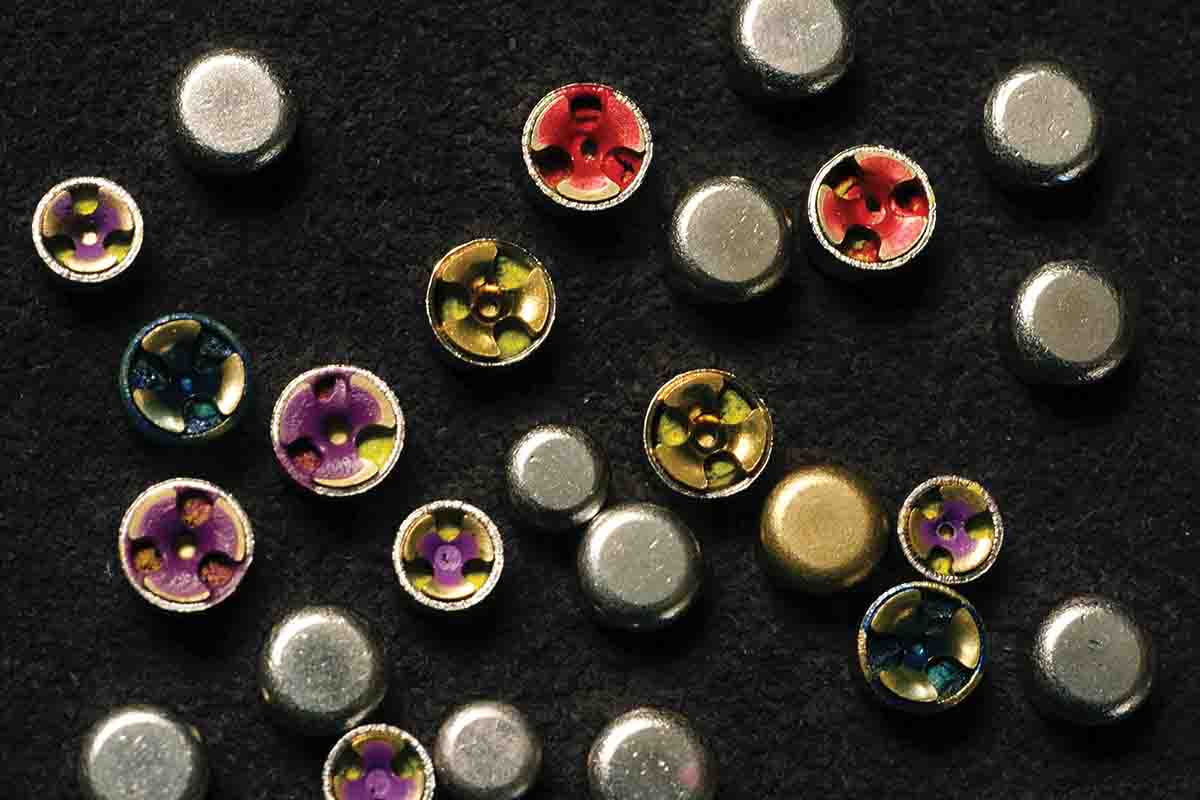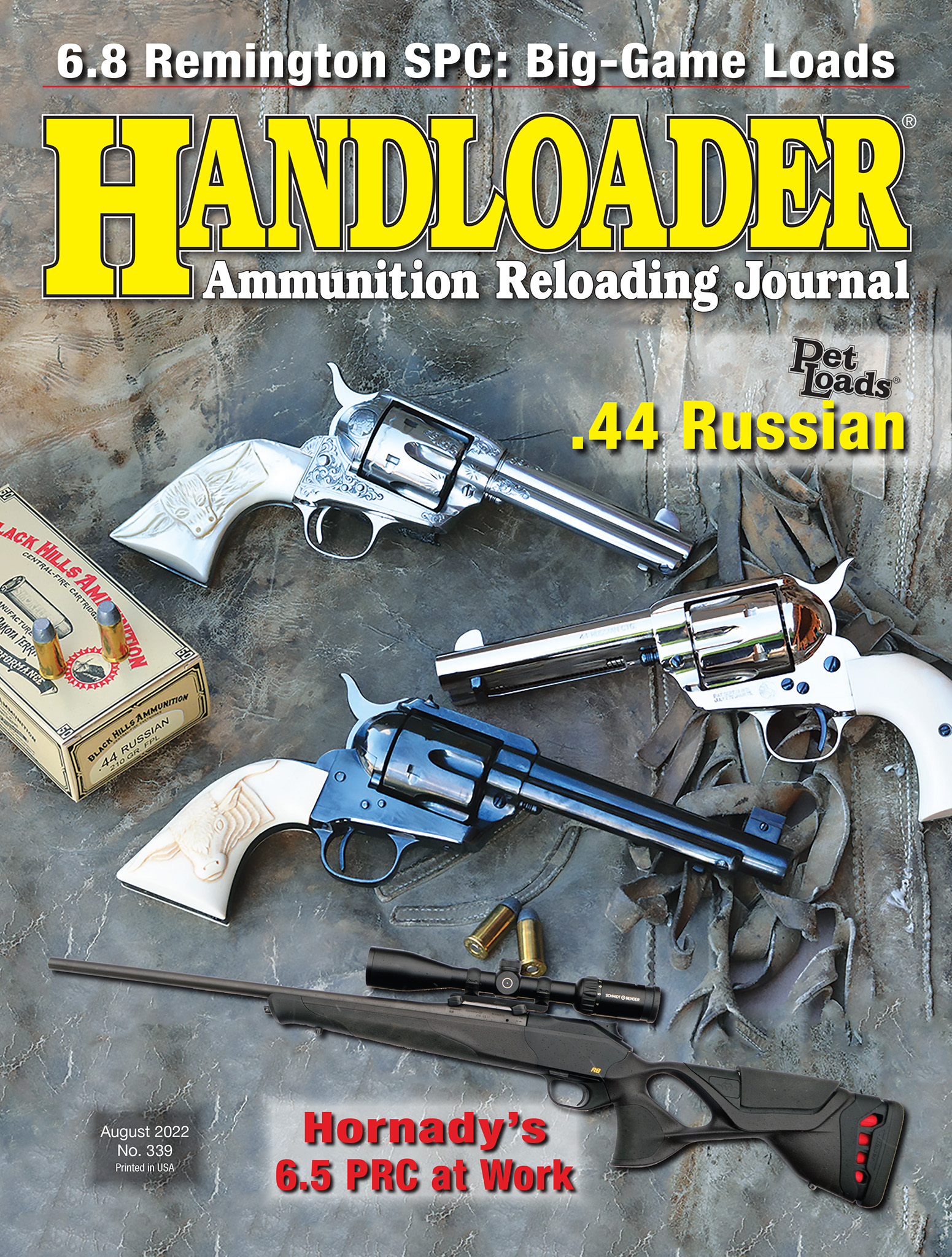In Range
A Primer Primer
column By: Terry Wieland | August, 22

Those irreplaceable little spark plugs of centerfire ammunition are the one component we cannot make for ourselves one way or the other. Hunters can, however, improvise by substituting. By this, I mean using a small pistol instead of a small rifle, or a large rifle magnum in place of a plain large rifle, to give just two examples.
As with most things to do with handloading, this requires, above all, caution, and if a handloader wants to get decent results, careful thought. This applies to primers for pistols, rifles and shotguns alike. I should also add that every manufacturer of loading components enjoins against substituting anything, anywhere, anytime – and this goes double when dealing with any load up around maximum.
The most common question is: Can you use a small rifle primer in place of a small pistol, or large rifle in place of large pistol, or, in both cases, vice versa? The general answer is, Yes you can, but there are three things to be wary of.
First, size: While the diameters may be the same, the depth of the primer may vary. For example, a small rifle primer in a small pistol case may be slightly proud of the primer pocket. In a semiauto, which slams the cartridge into the chamber, there could be a premature ignition. Primers are supposed to be seated .005/.007 inch below level in the pocket, and a handloader soon gets used to judging, with their fingertip, if it’s too low, too high, or just right.
A primer that is too thin – typically, a small pistol primer in a small rifle case – may seat too deeply, and cause misfires if the rifle has a particularly gentle firing-pin strike, or if the pin is slightly short. As well, primer pockets themselves vary in depth from one brand of brass to another. I’ve used some European small-pistol cases with primer pockets that were slightly smaller in diameter, causing some primers to crush instead of seating.
Second, its hardness. Pistol primers are typically softer than rifle primers. A pistol primer in a rifle case could be pierced by the hard strike of the firing pin; conversely, a rifle primer in a pistol could have a misfire because the strike is too gentle.
Finally, there is brisance – the strength, if you will – of the flame. Magnum primers are hotter than standard ones in both pistol and rifle cartridges. This doesn’t mean a handloader can’t use a magnum primer where a standard one is called for, but it’s vital to back off the powder charge to a starting load to see how it works.
A worst-case scenario would have all of the above occurring in one situation, which could make life more interesting than someone would really want it to be.
Some European shotgun primers are ever-so-slightly smaller in diameter than American-made ones. They fit cases imported from Europe for special purposes, such as the paper cases from RST, but might be loose in an American hull, even to the point of falling out. Conversely, trying to seat an American primer in a European case could result in a crushed or deformed primer, proud of the base and looking for a way to cause trouble.
Primers have been tricky little guys from the beginning, all the way back to the 1860s when Col. Hiram Berdan (American) was developing the Berdan primer, and Col. Edward Mounier Boxer (English) was developing the primer that bears his name. In an inexplicable quirk of history, the Boxer primer with its integral anvil became the American standard, while Europeans almost universally went for the American Berdan, with the anvil as part of the primer pocket.
The main practical difference is that Boxer cases have a single flash hole, through which the used primer can be ejected. For reloading purposes, depriming a Berdan case is trickier.
The main thing to be wary of is ensuring you know what kind of case you’re dealing with if depriming unfamiliar brass and who, these days, is not scraping by with strange brass of one description or another? Trying to deprime a Berdan case with a standard depriming rod results in a broken rod.
Then there is the question of unfamiliar primers. I have not come across this, but others apparently have – finding primers for sale that are a brand they don’t recognize, or old stock some gun shop owner found when he was searching through the back shelves. Aside from the obvious advice to play it ultra-safe in terms of starting loads, there are a couple of other potential hazards.
The first is the priming compound itself. A century ago, fulminate of mercury was standard, but mercury causes brass to become brittle: This was replaced by potassium chlorate, which caused steel bores to rot like cheap lumber if they were not cleaned, thoroughly and properly, right after shooting.
The most common non-corrosive priming compound was lead styphnate, which in recent years has been condemned under the broad “anti-lead” banner. This has led to the development of unleaded fulminates for use in indoor ranges. None of this really matters to the handloader of today, except that one occasionally comes across some old U.S. military target ammunition – usually .30-06 – which uses potassium chlorate primers. Because they were more accurate, the military stuck to these for years after non-corrosive priming was available.
If you come across some military match ammunition of indeterminate age, it pays to find out how to clean your bore properly, and then do it promptly. If it turns out the primers were not corrosive, you haven’t harmed anything and your rifle may appreciate a good scrubbing anyway.
To get back to the interchangeability of rifle primers, a handloader should be especially careful using a standard primer in a large magnum case filled with slow-burning powder.
A dozen years ago, I had the dubious privilege of shooting a .585 GMA – Granite Mountain’s entry in the seriously overpowered hunting rifle sweepstakes. There were several such cartridges from various sources, mostly .577s intended to emulate the .577 Nitro Express in bolt rifles. So much powder was packed into the GMA case that there were concerns about the ability of any primer, even stalwarts like Federal’s F215M, to set it alight. Around that time, Federal developed the F217 primer, if memory serves, intended for cartridges based on the .50 BMG case, which were then all the rage. But it was not available on the retail market.
But back to the .585 GMA. It was a monster, but I was assured that all ignition problems had been overcome. Holding on like grim death, I leveled the rifle at the earthen berm and pulled the trigger. There was a ‘click,’ then nothing. Just as I started to lower the rifle and look around, it went off with a tremendous boom and an equally tremendous recoil that sent the rifle in an arc up and over my head. Fortunately, I was still hanging on, and managed to bring it to a stop, a foot above the gravel, pointing back at the crowd which had gathered to witness this event.
That was the single worst hangfire I’ve ever had, but it proves several things. One, creating a cartridge to provide, frankly, more power than is needed for any animal on earth in any situation, can cause a lot of unexpected problems. Two, wait a good 30 seconds after a hangfire before you lower your guard.
Everything I’ve discussed here is really erring on the side of caution, but I learned long ago that’s a good habit to get into. If you never want to be faced with the necessity of substituting primers, here’s the answer: When they become freely available again, lay in a supply.


